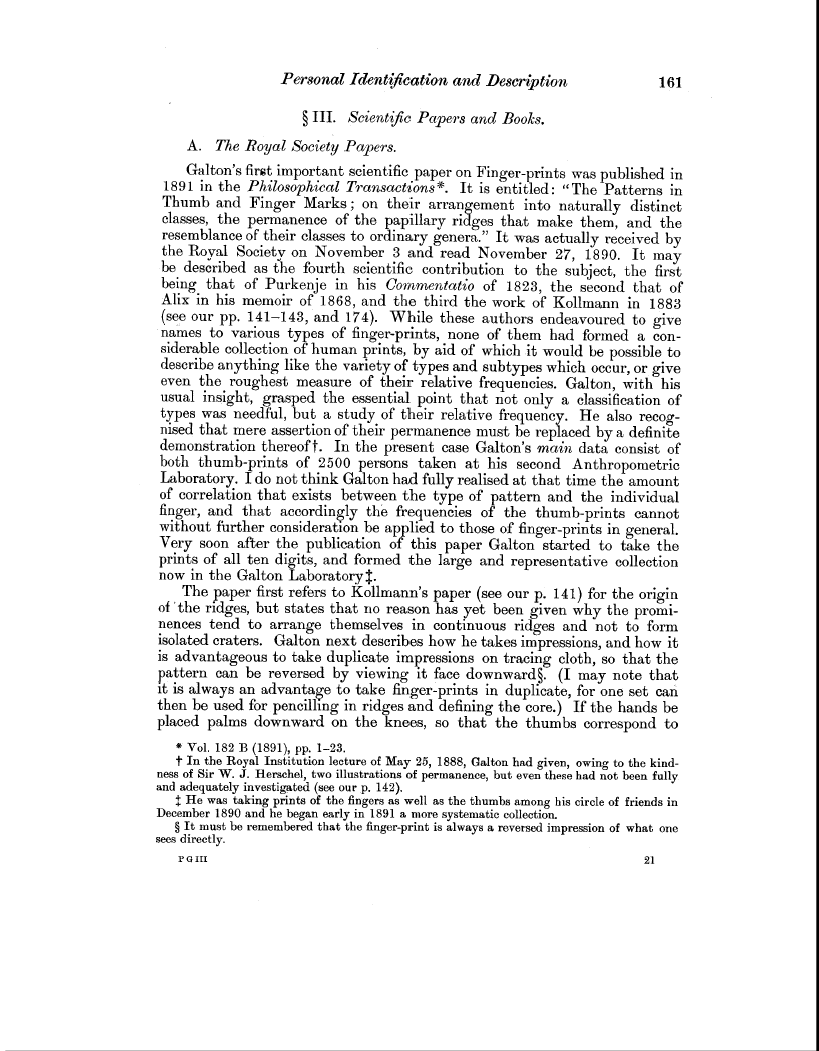| ||||||

OCR Rendition - approximate
Personal Identification and Description 161 § III. Scientific Papers and Books. A. The Royal Society Papers. Galton's first important scientific paper on Finger-prints was published in 1891 in the Philosophical Transactions*. It is entitled: "The Patterns in Thumb and Finger Marks ; on their arrangement into naturally distinct classes, the permanence of the papillary ridges that make them, and the resemblance of their classes to ordinary genera." It was actually received by the Royal Society on November 3 and read November 27, 1890. It may be described as the fourth scientific contribution to the subject, the first being that of Purkenje in his Commentatio of 1823, the second that of Alix in his memoir of 1868, and the third the work of Kollmann in 1883 (see our pp. 141-143, and 174). While these authors endeavoured to give names to various types of finger-prints, none of them had formed a considerable collection of human prints, by aid of which it would be possible to describe anything like the variety of types and subtypes which occur, or give even the roughest measure of their relative frequencies. Galton, with his usual insight, grasped the essential point that not only a classification of types was needful, but a study of their relative frequency. He also recognised that mere assertion of their permanence must be replaced by a definite demonstration thereof t. In the present case Galton's main data consist of both thumb-prints of 2500 persons taken at his second Anthropometric Laboratory. I do not think Galton had fully realised at that time the amount of correlation that exists between the type of pattern and the individual finger, and that accordingly the frequencies of the thumb-prints cannot without further consideration be applied to those of finger-prints in general. Very soon after the publication of this paper Galton started to take the prints of all ten digits, and formed the large and representative collection now in the Galton Laboratory t. The paper first refers to Kollxnann's paper (see our p. 141) for the origin of "the ridges, but states that no reason has yet been given why the prominences tend to arrange themselves in continuous ridges and not to form isolated craters. Galton next describes how he takes impressions, and how it is advantageous to take duplicate impressions on tracing cloth, so that the pattern can be reversed by viewing it face downward§. (I may note that it is always an advantage to take finger-prints in duplicate, for one set can then be used for pencilling in ridges and defining the core.) If the hands be placed palms downward on the knees, so that the thumbs correspond to * Vol. 182 B (1891), pp. 1-23. t In the Royal Institution lecture of May 25, 1888, Galton had given, owing to the kindness of Sir W. J. Herschel, two illustrations of permanence, but even these had not been fully and adequately investigated (see our p. 142). $ He was taking prints of the fingers as well as the thumbs among his circle of friends in December 1890 and he began early in 1891 a more systematic collection. § It must be remembered that the finger-print is always a reversed impression of what one sees directly. P 0111 21
|